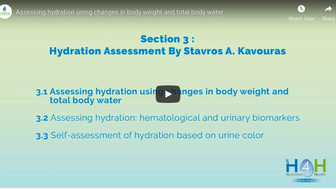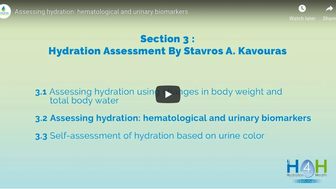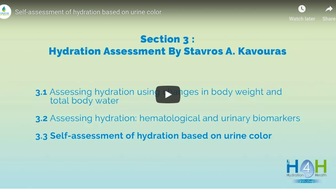Module 3: Hydration Assessment
Many techniques have been used to assess hydration over the years. One of the most widely used one is based on changes in body weight. This techniques, offers a unique advantage of providing a very precise quantification of the water deficit. It is usually the method of choice in a laboratory setting when dehydration is being induced to examine different outcomes. This technique is based on the assumption that acute body weight changes reflects changes in body water content.
However, in daily practice when euhydrated baseline body weight is not available and body weight fluctuates during the day, this technique is not as good. Blood and urine biomarkers have been widely used as a way to assess hydration. Blood biomarkers, like blood osmolality, can examine acute changes in hydration during dynamic and rapid changes in body water like as a response to exercise-induced dehydration. Urine biomarkers like osmolality or specific gravity are better in estimating long-term changes and better reflect differences in water intake practices. Urine color has been widely used and validated in many different settings as a practical and easy tool of hydration assessment.
Learning objectives
- To understand the use of different biomarkers in a laboratory or a free leaving condition
- To cover the benefits and limitations of the blood urine biomarkers
- To explain the use of urine color as a method hydration self-assessment in daily life.
References
- Armstrong LE, Kavouras SA, Walsh NP, Roberts WO. Diagnosing dehydration? Blend evidence with clinical observations. Curr Opin Clin Nutr Metab Care. 2016;19:434–8.
- Armstrong LE. Assessing hydration status: the elusive gold standard. J Am Coll Nutr. 2007;26:575S–584S.
- Kavouras SA, Johnson EC, Bougatsas D, Arnaoutis G, Panagiotakos DB, Perrier E, Klein A. Validation of a urine color scale for assessment of urine osmolality in healthy children. Eur J Nutr. 2016;55:907–15.









